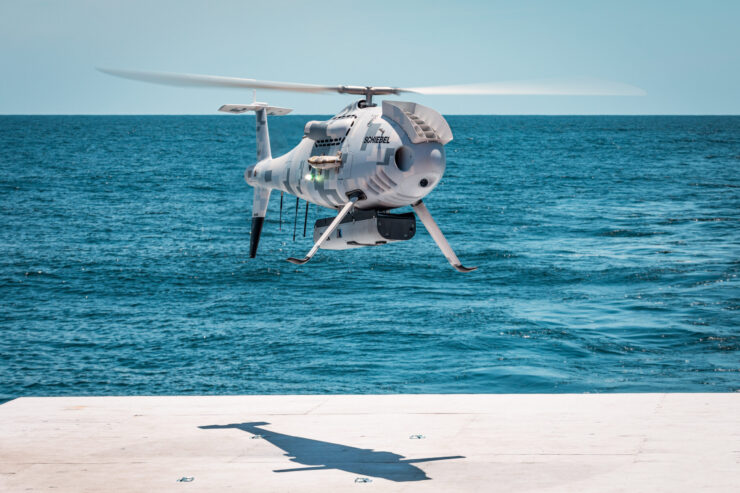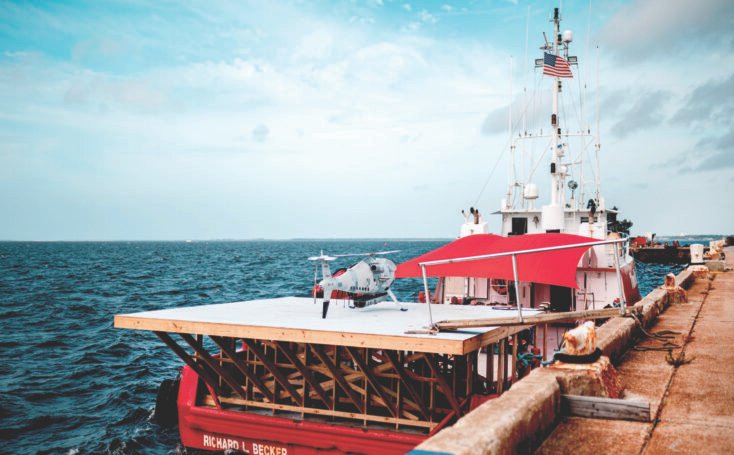 The Schiebel Group, based in Vienna focuses on the development and production of high-tech VTOL Unmanned Air Systems. Schiebel’s CAMCOPTER S-100 is a market leader in its class.
The Schiebel Group, based in Vienna focuses on the development and production of high-tech VTOL Unmanned Air Systems. Schiebel’s CAMCOPTER S-100 is a market leader in its class.
In an exclusive interview with Ajit Kumar Thakur – Editor, Raksha Anirveda, Neil Hunter, Global Head of Business Development at Schiebel spoke at length about the company’s global footprint and its futuristic “Make in India” plan of expansion in India. An excerpt:
RA: Schiebel CAMCOPTER® S-100 has customers across the continents. Tell us about the story behind the evolution and development of CAMCOPTER® S-100 platform.
NH: Schiebel was founded in 1951 in Vienna, Austria, and we have come a long way since then. The now globally operating Schiebel Group focuses on the development, design and production of the CAMCOPTER® S-100 Unmanned Air System (UAS). We have built an international reputation for producing high-tech military, commercial and humanitarian products over the years.
We have customers on five of the world’s continents; a mixture of military, governmental, NGO and commercial customers. Notably, over the last 3 years, Schiebel has won multiple contracts with the European Maritime Safety Agency (EMSA). In the execution of these contracts the S-100 provides simultaneous maritime surveillance services to several EU Member States and its coast guards, e.g. in Spain, Finland, Romania and Estonia.
In July 2021, the Royal Australian Navy (RAN) awarded Schiebel with a 3-year extension contract for the sustainment of its CAMCOPTER® S-100. The extension allows the RAN to continue to experiment and develop knowledge of the employment of UAS in the maritime domain, using the S-100.
Other current clients include the UK Coast Guard, Royal Thai Navy, French Navy and the Indonesian Navy. Building on its vast experience, Schiebel also demonstrated the S-100 to the Hellenic Navy and the US Navy this summer.
RA: To remain ahead in competition, UAV technology demands continuous R&D, investment and testing. What proportion of its revenue earnings Schiebel reinvests for future development of S-100?
NH: Schiebel invests 20 per cent of its annual revenue into Research and Development. The CAMCOPTER® S-100 is continuously being developed using state-of-the-art materials and technology. As part of the investment, the company acquired a titanium 3D printer back in 2020 to enable valuable weight savings and design freedom. The needs of our customers are our number one priority. Their experiences and their feedback are the basis of our development process.
RA: What features, role play and functions of the CAMCOPTER S-100 differentiates it from others? Please elaborate.
NH: The UAS has gained extensive experience around the world over the last 15 years and has amassed several hundred thousand flight hours, with thousands of maritime flight hours under its belt. It is being operated by 14 navies worldwide.

The S-100 is a multi-role, multi-domain UAS, which caters to the specialised needs of navies, armies and air forces alike. The payload-agnostic unmanned aircraft allows customers to add a robust and value for money “eye in the sky” to their existing capabilities, allowing for the provision of Intelligence, Surveillance and Intelligence (ISR), search and rescue, environmental protection, vessel detection and cargo delivery – just to name a few.
The major differentiator compared to fixed wing systems, which use catapult launch systems, is that the S-100 can operate from any ship with a small helicopter landing deck or suitable space, even in challenging weather. Catapult launch systems are very cumbersome for usage at sea, whereas VTOL UAS are ideally suited due to their small footprint.
RA: Schiebel is developing a larger and heavier rotary-wing UAV S-300 in its Camcopter range. How is the S-300 development work progressing and when do you expect it to come into service?
NH: We have been working on the development of the S-100’s bigger brother, the S-300. Figures are yet to be completely finalised, but we estimate it will come up at 600-750 kg Maximum Take-Off Weight, which will give a maximum payload capacity of around 250 kg. Maximum endurance should reach about 20 hours with a light payload. There are still some technical milestones, which need to be overcome, before being able to announce when exactly the S-300 will become available to the market.
RA: Recently, conducted the world’s first unmanned cargo delivery to an active oil and gas platform in Norway. Do you think in context of the ongoing debate between the Manned Versus Unmanned, the later has an edge both for defence and civilian use? What’s your take in support for unmanned solutions?
NH: India has more than 7000 km of coast line dotted with various oil and gas platforms and other sea borne assets. Both the military and civil domain has accepted and is using unmanned systems and the new set of drone rules and regulations has provided the basis framework, leading to a huge amount of interest in unmanned systems.
Remote areas, such as oil and gas platforms or hilly terrain are perfectly suited for the S-100. The recent cargo delivery in Norway has resulted in major interest from the oil and gas industry. The most important factor, when operating UAS is that no human life is in danger, compared to flying with a manned helicopter, which is only one reason why the interest keeps growing.

RA: How was the experience at Aero India 2021? What are Schiebel Group expectations from the Indian market? Tell us in detail about your partnership with VEM Technologies and business strategy to tap Indian market – in particular defence sector and participate in government’s make in India initiative.
NH: Given our increased focus on the Indian market due to the large number of developing requirements for Unmanned Air Systems (UAS), exhibiting at Aero India 2021 was a logical step. At the event, we were able to generate a lot of interest among potential military customers, including Chief of Defence Staff (CDS), Chief of Naval Staff (CNS), Chief of Air Staff (CAS) and various heads of directorates dealing with unmanned systems in the Army, Navy and Air Force. The exhibition provided us with a holistic picture of the unmanned landscape in India and how it is set to grow in the next decade. We want to be part of this growth story and have a long-term relationship with VEM Technologies, who are supporting us in our endeavour. Currently, we are bidding for the Indian Navy’s Naval Ship-borne Unmanned Aerial System (NSUAS) Fast Track Programme that will deliver Intelligence, Surveillance and Reconnaissance (ISR) capability at sea.
RA: CAMCOPTER® S-100 is considered to be an extremely flexible, multi-role, multi-domain asset. How it fits into the unique requirements of Indian Armed Forces? What futuristic capabilities can Schiebel offer to them?
NH: The unique requirements of the Indian Armed Forces are defined by the types of terrain and the kind of weather, which the military has to face at high seas and its borders. The S-100 provides the best option to the Indian Navy, where the weather is unpredictable and an autonomous VTOL UAS is the ideal solution to meet the tactical ISR requirements. The range and endurance of the CAMCOPTER® S-100 provides a dedicated “eye in the sky” for meeting the needs of the Army, Navy, Air Force and the Coast Guard. In addition, the Manned Unmanned-Teaming (MUM-T) opens a plethora of usage options for both the tactical ISR as well as Search and Rescue.
RA: Are you participating in the mega defence event DEFEXPO 2022? If yes, kindly provide insights into your plan to showcase your product offerings.
NH: Yes, as part of our growth strategy in India, we will definitely exhibit at DEFEXPO 2022 and we’re looking forward to further strengthening our network and to showcase the unrivalled capabilities of our S-100. We are also in the process of setting up a local office and company in India to focus on long-term business in the region. We want to support and grow with the Indian industry by creating jobs and developing technology and offering the best Vertical Takeoff and Landing (VTOL) UAS available in the global market.








